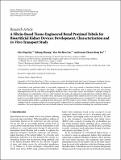| dc.contributor.author | Ng, Chee Ping | |
| dc.contributor.author | Zhuang, Yuhang | |
| dc.contributor.author | Lin, Alex Wei Haw | |
| dc.contributor.author | Teo, Jeremy Choon Meng | |
| dc.date.accessioned | 2013-03-06T13:40:10Z | |
| dc.date.available | 2013-03-06T13:40:10Z | |
| dc.date.issued | 2013 | |
| dc.date.submitted | 2012-08 | |
| dc.identifier.issn | 2314-4416 | |
| dc.identifier.uri | http://hdl.handle.net/1721.1/77569 | |
| dc.description.abstract | A bioartificial renal proximal tubule is successfully engineered as a first step towards a bioartificial kidney for improved renal substitution therapy. To engineer the tubule, a tunable hollow fiber membrane with an exterior skin layer that provides immunoprotection for the cells from extracapillary blood flow and a coarse inner surface that facilitates a hydrogel coating for cell attachment was embedded in a “lab-on-a-chip” model for the small-scale exploratory testing under flow conditions. Fibrin was coated onto the inner surface of the hollow fiber, and human renal proximal tubule epithelial cells were then seeded. Using this model, we successfully cultured a confluent monolayer, as ascertained by immunofluorescence staining for ZO-1 tight junctions and other proximal tubule markers, scanning electron microscopy, and FITC-inulin recovery studies. Furthermore, the inulin studies, combined with the creatinine and glucose transport profiles, suggested that the confluent monolayer exhibits functional transport capabilities. The novel approaches here may eventually improve current renal substitution technology for renal failure patients. | en_US |
| dc.publisher | Hindawi Publishing Corporation | en_US |
| dc.relation.isversionof | http://dx.doi.org/10.1155/2013/319476 | en_US |
| dc.rights | Creative Commons Attribution | en_US |
| dc.rights.uri | http://creativecommons.org/licenses/by/2.0 | en_US |
| dc.source | Hindawi Publishing Corporation | en_US |
| dc.title | A Fibrin-Based Tissue-Engineered Renal Proximal Tubule for Bioartificial Kidney Devices: Development, Characterization and In Vitro Transport Study | en_US |
| dc.type | Article | en_US |
| dc.identifier.citation | Ng, Chee Ping et al. “A Fibrin-Based Tissue-Engineered Renal Proximal Tubule for Bioartificial Kidney Devices: Development, Characterization and In Vitro Transport Study.” International Journal of Tissue Engineering 2013 (2013): 1–10. | en_US |
| dc.contributor.department | Singapore-MIT Alliance in Research and Technology (SMART) | en_US |
| dc.contributor.mitauthor | Ng, Chee Ping | |
| dc.relation.journal | International Journal of Tissue Engineering | en_US |
| dc.eprint.version | Final published version | en_US |
| dc.type.uri | http://purl.org/eprint/type/JournalArticle | en_US |
| eprint.status | http://purl.org/eprint/status/PeerReviewed | en_US |
| dc.date.updated | 2013-02-24T09:17:17Z | |
| dc.language.rfc3066 | en | |
| dc.rights.holder | Copyright © 2013 Chee Ping Ng et al. This is an open access article distributed under the Creative Commons Attribution License, which permits unrestricted use, distribution, and reproduction in any medium, provided the original work is properly cited. | |
| dspace.orderedauthors | Ng, Chee Ping; Zhuang, Yuhang; Lin, Alex Wei Haw; Teo, Jeremy Choon Meng | en |
| mit.license | PUBLISHER_CC | en_US |
| mit.metadata.status | Complete | |
